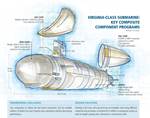Software enables submarine shipyard’s composites-for-metal effort
When Howaldtswerke-Deutsche Werft GmbH (Kiel, Germany) looked for a software solution to reduce the risk of using composites for a greater range of thicker parts, FiberSIM software from VISTAGY Inc. (Waltham, Mass.) enabled its engineers to develop initial designs more quickly and to better understand the impact of design changes.
Composite materials have slowly earned their way onto submarines for decades. For its part, Howaldtswerke-Deutsche Werft GmbH (HDW, Kiel, Germany) has increased composites usage on its vessels by 10 percent per year since 2008, thanks to FiberSIM software (VISTAGY Inc., Waltham, Mass.).
A submarine source since 1897, HDW is the leading builder of non-nuclear-powered submersible vessels and the only one to offer fuel-cell-powered submarines. Three years ago, the company set out to use more composites, targeting vessel weight reduction and improved hydrodynamic stability, stealth and sonar transmission. Cutting costs via parts consolidation was another big goal, says Marc Tillmanns, HDW’s lead composites engineer. But the worry was that large, thick parts would be difficult to produce and document accurately.
When HDW looked for a software solution to reduce the risk of using composites for a greater range of thicker parts, FiberSIM enabled its engineers to develop initial designs more quickly and to better understand the impact of design changes because design is better linked to manufacturing: “FiberSIM takes a lot of the worry out of the process by capturing the details of the final layups and verifying specifications with the software’s design verification tools,” says Tillmanns. Accurate flat patterns can be produced quickly, showing dart and splice placement, without trial and error, which previously wasted time and materials on the shop floor. Further, the software tracks the variety of materials that HDW uses and enables precise calculation of material weight and resulting inertial properties of the parts. The company also employs FiberSIM’s Laser Projection software to reduce layup errors and labor during part layup, using a projection system built by SL-Laser Systems LLC (Charlotte, N.C.).
With FiberSIM, HDW has added a variety of glass and carbon parts on its Class 214 submarines, including the complete upper deck, keel covers, tower sail fairings (cusps), propeller blades and rudders. More parts will follow, including a torpedo storage rack. “FiberSIM allows us to convert from metal to composite faster and minimizes the risk by verifying information before we get to the manufacturing floor,” says Tillmanns. “There’s no question that composites will grow in prominence for us, going forward.”
Related Content
-
European boatbuilders lead quest to build recyclable composite boats
Marine industry constituents are looking to take composite use one step further with the production of tough and recyclable recreational boats. Some are using new infusible thermoplastic resins.
-
CEAD launches the Maritime Application Center dedicated to industrial 3D printing boat hulls
The MAC is an LFAM-powered production facility equipped with highly automated, digitally driven manufacturing processes and built around a collaborative model to develop the boats of the future.
-
Hybrid composite architecture enables rigid wind propulsion solution for maritime decarbonization
GT Wings’ AirWing leverages aerospace engineering principles combined with hybrid glass and carbon fiber composite construction to deliver up to 30% fuel savings through compact, deck-compatible wind propulsion.






